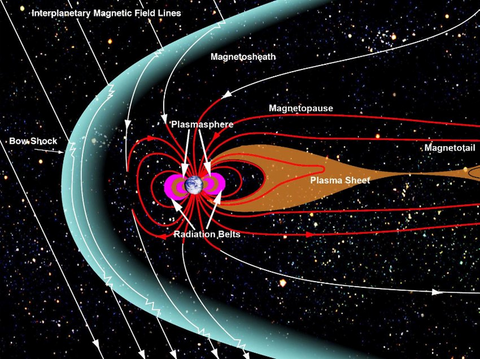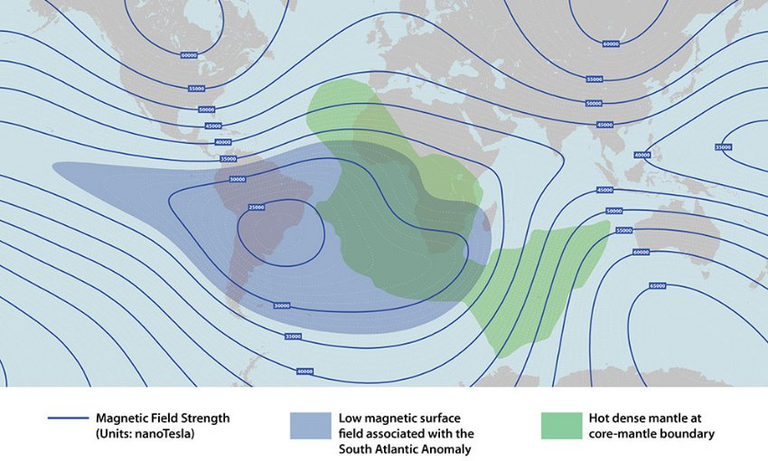Old African huts reassure us about the geomagnetic field

The invisible protective shield of Earth is weakening. The Earth’s magnetic field, reaching far into space, is still protecting our planet from radiations. But for the past 180 years, it has grown steadily weaker.
Should this trend go on, at some point the poles will reverse – the needle of compasses will then be pointing South, no longer North. During this phase of reversal, dangerous cosmic radiation would rain ever harder on Earth.
Right now, the magnetic pole, which happens to be close to the geographical North Pole, is shifting some 50km a year from Canada in the direction of Russia. And the magnetic field has significantly decreased in some places.
The biggest of these weak spots lies in a large area reaching from South Africa to South America: over the South Atlantic, airline passengers are subjected to radiation 1,000 times higher than on other air routes at flying altitude. At these latitudes, the crew of the International Space Station receives 90 percent of it‘s radiation dosis, despite the fact that it is staying there only about ten minutes every day.
Scientists believe that it is in these regions that the next polar reversal will take ist start. If these zones expand in surface, and if other similar zones appear, then the reversal will get going.
In order to know if things will reach that point, scientists are trying to discover how the magnetic field has evolved in earlier centuries. A probant answer is now being brought by the floors of thousand years old clay huts in Africa.
These floors are keeping an imprint of the magnetic field as it was in prior centuries – thanks to a local custom: the inhabitants of the banks of Limpopo-River, at the border of South Africa with Zimbabwe and Botswana, used to ritually burn down their huts when there was a drought.
The heat of the fire, reaching above 1,000 deg Celsius, transformed the clay: when the fire died out and the soil cooled down, magnetic minerals contained in the clay shifted position to align themselves with the magnetic field such is as it was reigning at the time.
Moreover, the presence of particles with a measurable rate of radioactive decay make it possible to determine accurately the age of these huts.
The surprising result: the thousand years of burning records point to a weak, old magnetic field: between 1000 and 1500 after Christ, the Earth magnetic field had decreased in that area by ca 30 per cent, according to geophysicist John Tarduno of the University of Rochester in the USA, who has been awarded a medal last month for his work at the annual meeting of the European Geosciences Union (EGU) in Vienna.
His African discovery is actually good news, says Tarduno. It shows that the Earth‘ magnetic field undergoes bouts of weakness more often than had been thought, and the present slowing down doesn’t seem to be particularly significant.
Meaning, that things are not necessarily heading in the direction of a pole shift; after all, the field recovered temporarily after a weak phase in the Middle-Ages, before it went into a crisis again 180 years ago.

The clay floors of the African huts reveal this magnetic field weakness of the Middle-Ages thanks to their magnetic particles: they froze into place, still pointing North, yet their angle, called inclination, varies in unusual ways.
Normally, compass needles stand vertically at the poles, horizontally at the equator, and are inclined in a middle position corresponding to the situations in-between. But when the magnetic field is disturbed, the inclination starts varying from one place to another in an almost chaotic manner.
The cause is not – as one might surmise – conditions kilometers above the surface of the Earth, but in our liquid inside: enormous differences in temperatures between the core and the mantle make the hot flowing liquid iron of the outer core circulate as in a cooking pot. The Earth’s rotation brews up this mass – and, as in the dynamo of a bicycle, out of motion, electricity is produced.
This electricity produces the magnetic field. And whereas the iron swirls tend to move just about parallel to the Earth’ axis, the magnetic poles are almost always close to the geographic poles.
The fluctuations of the magnetic field at the surface of the Earth mirror the mighty rolling and milling inside. At present, the field is weakening because some parts of the dynamo have entered into a counter-motion, according to computer simulations.
The larger the so-called anti-dynamos grow, the weaker becomes the magnetic field. If at some point there are nore anti-dynamos than dynamos, a reversal occurs.
One of these regions is obviosuly located below South Africa. This shows in pictures which are obtained at the occasion of earthquakes: as with ultrasounds, the waves change their speed according to the material which they are going through – a softer substance slows down the waves.
Under South Africa, the South Atlantic and South America, at the edge of the Earth‘ core at a depth of some 3,000 kilometers, pictures reveal a zone of low speed – there, the rocks must be made up in a special way. A relation with the weak geomagnetic field comes to mind, says Tarduno: probably that the flow of liquid iron which produces the magnetic field is changing it's course at this spot.
This magnetic disturbance is well known by sea captains, who can read it on their compasses, too. The inclination of their compass needles varies as strongly as the inclinations registered in the clay floors of the African huts.
Roughly, the fluctuations of the geomagnetic field can be followed back for millions of years. The Earth’s solidified lava rocks too contain magnetisation. The examination of such rocks shows that the Earth‘ magnetic field reverses its poles on average every few hundreds of thousands of years.
The last reversal goes back 780.000 years. What doesn’t mean much to nature, could quickly become a problem to mankind. The highly energetic solar wind would reach deeply into the Earth’s atmosphere and disturb the circuit switches of computer chips. Especially at risk would be airplanes and satellites, and communications networks and energy grids.
Exact measurement data about the strength of the geomagnetic field exist only since 1840; since then, it has weakened by about 16 percent. But before that, the field was stable for centuries. And it might just turn out to be that way again, according to the reassuring assessment of Tardunos work on African clay huts.
Axel Bojanowski
Der Spiegel, April 26, 2017
Translated by Anne-Marie de Grazia

